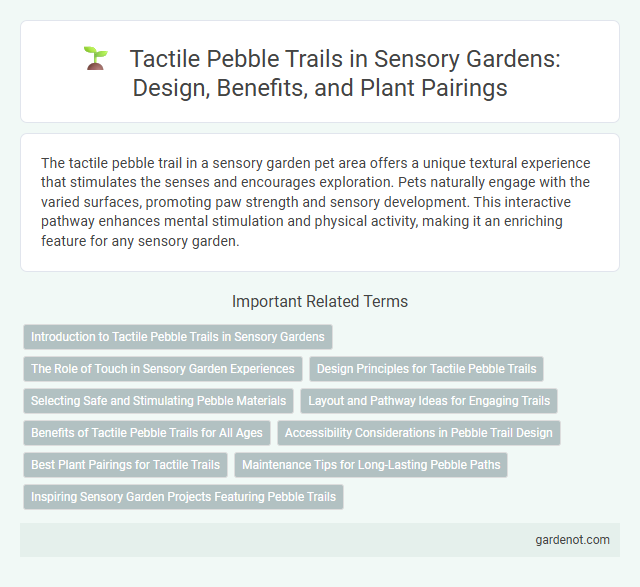The tactile pebble trail in a sensory garden pet area offers a unique textural experience that stimulates the senses and encourages exploration. Pets naturally engage with the varied surfaces, promoting paw strength and sensory development. This interactive pathway enhances mental stimulation and physical activity, making it an enriching feature for any sensory garden.
Introduction to Tactile Pebble Trails in Sensory Gardens
Tactile pebble trails in sensory gardens provide a unique walking experience by stimulating the sense of touch through varied pebble textures. These trails enhance sensory exploration and promote physical engagement for visitors of all ages and abilities. Incorporating tactile elements supports balance, coordination, and sensory integration in therapeutic garden settings.
The Role of Touch in Sensory Garden Experiences
Tactile pebble trails in sensory gardens stimulate the sense of touch by offering varied textures and shapes that encourage exploration and sensory engagement. These trails enhance tactile perception, motor skills, and mindfulness, promoting relaxation and cognitive development. Incorporating diverse pebble surfaces supports sensory integration, making the garden accessible and beneficial for individuals with sensory processing disorders.
Design Principles for Tactile Pebble Trails
Tactile pebble trails are designed using principles that emphasize varied textures and patterns to stimulate sensory exploration and enhance spatial awareness. The trail layout incorporates contrasting pebble sizes, shapes, and firmness to guide users safely while encouraging tactile engagement for both visually impaired individuals and sensory seekers. Strategic placement follows ergonomic standards to ensure comfort, accessibility, and seamless integration with the surrounding sensory garden landscape.
Selecting Safe and Stimulating Pebble Materials
Selecting safe and stimulating pebble materials for a tactile pebble trail involves using non-toxic, smooth, and durable stones that provide varied textures to engage the sense of touch. Pebbles should have rounded edges to prevent injury and be securely embedded to maintain stability and safety. Incorporating a mix of sizes and natural materials like river stones or polished pebbles enhances sensory stimulation and encourages exploration.
Layout and Pathway Ideas for Engaging Trails
A tactile pebble trail offers a dynamic layout designed to stimulate sensory exploration through varied pebble textures and patterns underfoot, encouraging balance and coordination. Incorporating winding pathways with alternating pebble sizes and materials creates engaging touch experiences while guiding visitors naturally through the garden. Strategic placement of contrasting tactile zones enhances sensory stimulation and invites repeated interaction along the trail.
Benefits of Tactile Pebble Trails for All Ages
Tactile pebble trails enhance sensory stimulation, promoting better balance and coordination for individuals of all ages. These textured paths support physical therapy and motor skill development in children while providing seniors with effective foot massage and improved circulation. Incorporating tactile pebble trails in sensory gardens enriches outdoor experiences, fostering relaxation and therapeutic benefits across generations.
Accessibility Considerations in Pebble Trail Design
Tactile pebble trails are carefully designed to enhance accessibility for individuals with visual impairments by incorporating textured surfaces that guide and stimulate the sense of touch. Optimal pebble size, spacing, and firmness ensure safe navigation, while contrasting colors improve visibility for users with partial sight. Compliance with ADA standards and the inclusion of continuous edges or raised borders further support orientation and prevent accidental veering off the path.
Best Plant Pairings for Tactile Trails
Tactile pebble trails enhance sensory gardens by integrating plants that complement diverse textures, such as lamb's ear (Stachys byzantina) for its velvety leaves and ornamental grasses like Festuca glauca for a fine, brushy feel. Pairing these with low-growing herbs like thyme or creeping sedum offers varied tactile experiences while maintaining ground cover that protects pebbles. Selecting drought-tolerant and non-toxic species ensures safety and sustainability along tactile trails.
Maintenance Tips for Long-Lasting Pebble Paths
Regularly sweeping the tactile pebble trail removes debris that can cause surface wear and maintain safety for all users. Periodic inspection for loose or damaged pebbles helps prevent tripping hazards and ensures consistent texture for sensory engagement. Applying a sealant every few years protects the pebbles from weathering and extends the lifespan of the tactile pathway in sensory gardens.
Inspiring Sensory Garden Projects Featuring Pebble Trails
Tactile pebble trails in sensory gardens provide a dynamic pathway that engages touch and proprioception through varied textures and shapes, enhancing sensory integration and cognitive stimulation. These pebble trails inspire innovative garden designs by incorporating natural materials that encourage barefoot exploration and mindfulness, promoting physical activity and emotional well-being. Sensory garden projects featuring tactile pebble trails often prioritize accessibility and therapeutic benefits, making outdoor spaces inclusive for individuals with diverse sensory needs.
Tactile pebble trail Infographic

 gardenot.com
gardenot.com